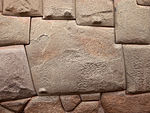

The jacal (həˈkɑːl; Mexican Spanish from Nahuatl xacalli contraction of xamitl calli; literally "hut") is an adobe-style housing structure historically found throughout parts of the Southwestern United States and Mexico.[1] This type of structure was employed by some aboriginal people of the Americas prior to European colonization and was later employed by both Hispanic and Non-Hispanic settlers in Texas and elsewhere. [2]
Typically, a jacal consisted of slim close-set poles tied together and filled out with mud, clay and grasses. More sophisticated structures, such as those constructed by the Ancestral Pueblo people, incorporated adobe bricks—sun-baked mud and sandstone.
Jacal construction is similar to wattle and daub. However, the "wattle" portion of jacal structures consists mainly of vertical poles lashed together with cordage and sometimes supported by a pole framework, as in the pit-houses of the Basketmaker III period of the Ancestral Puebloan (a.k.a. Anasazi) people of the American Southwest. This is overlain with a layer of mud/adobe (the "daub"), sometimes applied over a middle layer of dry grasses or brush which functions as insulation.
See also
[edit]External links
[edit]- Sketch of a Jacal Archived 2007-03-11 at the Wayback Machine from A pictorial history of Texas, from the earliest visits of European adventurers, to A.D. 1879, hosted by the Portal to Texas History[dead link].
References
[edit]- ^ "Texas-Mexican Vernacular Architecture". The Handbook of Texas online. Retrieved 17 Jun 2017.
- ^ "DeWitt Colony Life". Sons of DeWitt Colony Texas. Archived from the original on 5 December 2010. Retrieved 17 Jun 2017.
| Traditional immobile |
| |
|---|---|---|
| Traditional mobile | ||
| Open-air | ||
| Modern | ||
| Related topics | ||
| Styles | ||
|---|---|---|
| Building types | ||
| Structures | ||
| Elements | ||
| Native and indigenous | |
|---|---|
| Colonial and post-colonial | |
| Early Republic | |
| Mid-19th century | |
| Victorian | |
| Late-19th to mid-20th century |
|
| Post–World War II | |
| Building types and vernacular |
|
| Cities | |
| States | |

